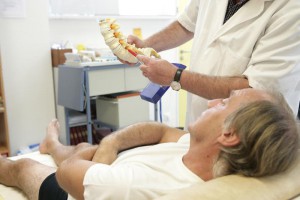Matching the Lumbar Patient to the Most Appropriate Treatment

For a patient with lumbar back pain, radiating leg pain or weakness, or other problems, an effective treatment may be elusive at first. Sometimes, patients don’t require surgery for lumbar conditions because nonsurgical approaches have been successful. A team of experts at a dedicated spine center can match the right treatment to individual patient needs.
The most effective consultation occurs when a patient has tried nonsurgical treatments for up to 12 weeks without success or has symptom recurrence; patients should have also undergone lumbar imaging, including magnetic resonance imaging (MRI) and x-rays. Additionally, if imaging reveals a deformity, a full-spine standing x-ray is an important way to assess sagittal and coronal alignment and upright posture and balance,” says Oren Gottfried, MD, a Duke spine neurosurgeon who works in all 3 areas of lumbar spine surgery. He notes that, ideally, MRI should be performed prior to his consultation to evaluate stenosis, but he can also facilitate obtaining the study to avoid delaying the meeting.
Minimally Invasive Surgery
Duke neurosurgeons specializing in spine surgery can perform many lumbar procedures using minimally invasive surgery (MIS). The goal of MIS is to accomplish all of the benefits of traditional, open spine surgeries with fewer injuries to the skin, muscles and, in some cases, nerves.
The rate of MIS complications is generally lower than those associated with open techniques, and patients may have quicker recoveries and experience decreased rates of blood loss. Some techniques approach the spine from the side or front, avoiding injury to the larger muscles of the back. Typically, MIS is accomplished with 1 or more small incisions and the assistance of scopes or tubes. But, for the most complex cases, such as deformity corrections, incisions are not always small.
Lumbar Neurosurgery
Three types of lumbar neurosurgery may be accomplished with MIS, and possible options are always discussed with patients for shared, informed decision making.
Lumbar decompressive laminectomy: If patients have tried nonsurgical treatments, have lumbar stenosis or compression on the nerves, and have normal structures to the spine without dynamic instability or deformity, then they may benefit from decompression surgery. The goal is to remove the point(s) of pressure, pinching, or stenosis, while leaving the stability structures of the spine intact.
In decompression surgery without need for instrumentation, healing may take weeks rather than months, which may not be the case with other back surgeries. “Surgery for decompression alone yields less disruption of the spine, shorter operative time, and a lower risk profile overall,” Gottfried says. Sometimes, the surgery can be accomplished through a small incision with tubes, cameras, or MIS equipment.
Lumbar fusion: When malalignment or spine instability is present, spinal fusion may be considered. Fusion usually requires posteriorly inserting metal, including rods, screws, and a bone graft, for greater success in the bones merging for improved long-term stability.
The hardware can be placed through less-invasive approaches. Some fusions require cages to be placed in the disc space as well, which can be performed from the posterior side, from the lateral side, or through the abdomen. The fusion is also often supplemented with decompressive laminectomy.
Historically, spine surgeons used a patient's own iliac bone, but this proved to be very painful. “Now, we more often use deceased-donor bone, local bone from the decompression, and other adjuncts like one’s own stem cells to help grow bone,” Gottfried says.
In addition, surgical approaches have become more versatile. Spine surgery can occur within 3 different planes, Gottfried says. “Now, hardware can be placed more effectively through less-invasive planes, thanks to new technology and more skilled surgeons.”
Lumbar deformities: Deformity surgeries are the most complex and involved of all the lumbar spinal surgeries; they also have the longest recovery time. Isaac Karikari, MD, a Duke neurosurgeon who focuses on spine issues, says risk rises with multiple corrections, so these types of surgeries are best performed in a high-volume center with deformity specialists.
A common cause of lumbar deformities is iatrogenesis, which, in this case, is defined as an operation that did not meet the original treatment goals. Another cause is scoliosis or kyphosis that has continued to worsen with age.
A Leader in the Field
Duke’s neurosurgical spine team is a leader in delicate deformity surgeries and has demonstrated a lower rate of medical complications (eg, stroke, myocardial infarction) and fewer intensive care unit admissions among patients with spine deformities. “Rates are at least one-third lower than the prevailing rate of complications in the United States,” according to Gottfried.
One of the reasons for achieving good outcomes is the diversified team at Duke, which offers comprehensive surgical and nonoperative care, along with behavioral pain management, other forms of supportive care, and pain management. Karikari notes that patients at the Duke Spine Center have access to all of Duke’s specialists, including neurosurgeons, orthopaedists, pain doctors, physiatrists, and psychologists.
To refer a patient, call 844-790-2013.